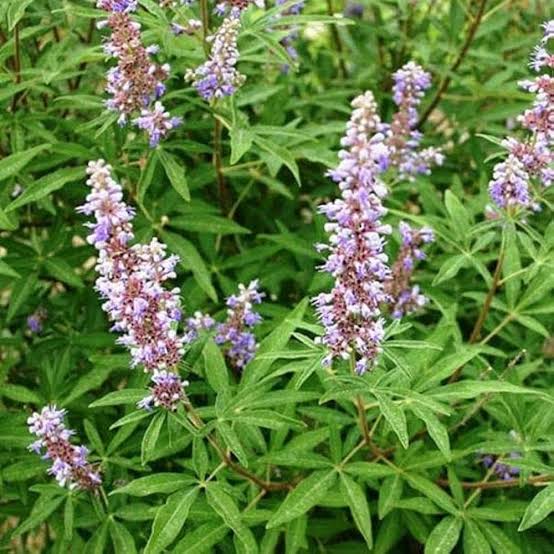Welcome to your holistic living

Botanical Name: Vitex negundo
Family: Lamiaceae
English Name: Five leaved chaste tree
Malayalam Name: Indrani
Hindi Name: Nirgandi, Mewri
Nirgundi (Vitex negundo Linn.) is a shrub widely distributed throughout India and often cultivated in gardens for its attractive appearance and medicinal value. The plant grows up to 12 feet in height, with branched cylindrical roots and a grey-pubescent stem bearing pinnately compound leaves that are digitately 3–5 foliate. The leaflets are oblanceolate, narrow, and acuminate, with the upper surface dark green to blackish and glabrous, and the lower surface greyish-white and pubescent, exuding a pleasant aromatic odour and bitter taste. The inflorescence is a dichasial cyme, and the flowers are bracteate, pentamerous, bisexual, zygomorphic, and complete, with 5 shortly toothed sepals and 5 petals arranged in an upper 2-lobed and a lower 3-lobed lip, purple to violet in colour. Stamens are five, while the gynoecium is bicarpellary, syncarpous with a superior ovary. The fruit is a small globose drupe containing ovate-oblong seeds with a straight embryo. Genuine drug samples (Grahya Lakṣaṇa) of roots are stout, cylindrical, 2–7 cm thick, externally greyish brown, longitudinally wrinkled with warty protuberances and scars, fibrous on breaking, aromatic, and bitter in taste. Market leaves are 3–5 foliate, with narrow lanceolate, acuminate leaflets measuring 5–12 cm long and 1.5–4 cm broad, dark and nearly glabrous above, greyish white beneath, with a characteristic aroma and bitterness. Three main varieties are described in the classics: Sinduvara, Nila Nirgundi, and Shephali.
Root, leaf
Vatavyadhi (Disorders of Vata) One Karsha (12 g) powder of root of Nirgundi (Vitex negundo) is taken with oil. It is very useful in case of Sandhivata (Osteo arthritis), Kativata (Lumbago) and Kampavata (Trembling). Kasa (Cough) Immunomodulatory Enhances immune defense by stimulating lymphocyte proliferation and regulating cytokines. Anti-inflammatory Reduces inflammation by inhibiting prostaglandins and other inflammatory mediators. Analgesic Provides pain relief by modulating pain pathways and reducing nerve sensitivity. Antimicrobial Fights bacterial and fungal infections through bioactive phytochemicals. Antioxidant Protects cells from oxidative damage by scavenging free radicals. Hepatoprotective Shields the liver from toxin-induced injury via antioxidant and detoxifying action. Anti-asthmatic Relieves respiratory distress by bronchodilation and reducing airway inflammation. Antipyretic Helps reduce fever by acting on thermoregulatory centers and lowering prostaglandins. Wound healing Promotes tissue repair by enhancing collagen synthesis and reducing microbial load. Anti-arthritic Eases joint pain and swelling by regulating inflammatory responses in synovial tissues. Powder of Nirgundi (Vitex negundo) root if taken internally, very useful in case of Epilepsy.
Leaf - Antiparasitic, Vermifuge, Anodyne and Alterative Root-Tonic, Febrifuge, Expectorant, Diuretic Fruit-Emmanogogue
Rasa: Tikta, Katu, Kashaya
Guna: Laghu, Ruksa
Virya: Usna
Vipaka: Katu
Dosha Karma: Vatakapha shamaka